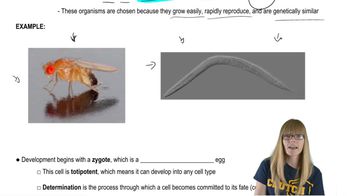The floral homeotic genes of Arabidopsis belong to the MADS-box gene family, while in Drosophila, homeotic genes belong to the homeobox gene family. In both Arabidopsis and Drosophila, members of the Polycomb gene family control expression of these divergent homeotic genes. How do Polycomb genes control expression of two very different sets of homeotic genes?
Table of contents
- 1. Introduction to Genetics51m
- 2. Mendel's Laws of Inheritance3h 37m
- 3. Extensions to Mendelian Inheritance2h 41m
- 4. Genetic Mapping and Linkage2h 28m
- 5. Genetics of Bacteria and Viruses1h 21m
- 6. Chromosomal Variation1h 48m
- 7. DNA and Chromosome Structure56m
- 8. DNA Replication1h 10m
- 9. Mitosis and Meiosis1h 34m
- 10. Transcription1h 0m
- 11. Translation58m
- 12. Gene Regulation in Prokaryotes1h 19m
- 13. Gene Regulation in Eukaryotes44m
- 14. Genetic Control of Development44m
- 15. Genomes and Genomics1h 50m
- 16. Transposable Elements47m
- 17. Mutation, Repair, and Recombination1h 6m
- 18. Molecular Genetic Tools19m
- 19. Cancer Genetics29m
- 20. Quantitative Genetics1h 26m
- 21. Population Genetics50m
- 22. Evolutionary Genetics29m
14. Genetic Control of Development
Developmental Patterning Genes
Problem 22a
Textbook Question
Vulval development in C. elegans is dependent on the response of some of the central epidermal progenitor cells in the region of the developing vulva to a chemical signal from the gonad. Signaling from the gonad is blocked by action of the vulvaless mutant let-23 so that none of the central progenitor cells form vulval structures. In the vulvaless mutant, n300, the central progenitor cells do not form.
Which gene is likely to act earlier in the vulval developmental pathway?
 Verified step by step guidance
Verified step by step guidance1
Understand the biological context: Vulval development in C. elegans involves a signaling pathway where the gonad sends a chemical signal to central epidermal progenitor cells, triggering them to form vulval structures.
Identify the role of the let-23 gene: The let-23 gene encodes a receptor that receives the gonadal signal. In the vulvaless mutant let-23, this signaling is blocked, so the progenitor cells receive no signal and fail to form vulval structures.
Analyze the phenotype of the n300 mutant: In the n300 vulvaless mutant, the central progenitor cells themselves do not form, indicating a defect earlier in development than just signal reception.
Compare the positions of the genes in the developmental pathway: Since let-23 affects the response to the signal but the progenitor cells are present, and n300 mutants lack the progenitor cells entirely, the gene mutated in n300 likely acts upstream of let-23, controlling progenitor cell formation.
Conclude that the gene mutated in n300 acts earlier in the vulval developmental pathway than let-23 because it affects the presence of progenitor cells, which is a prerequisite for the signaling step mediated by let-23.
 Verified video answer for a similar problem:
Verified video answer for a similar problem:This video solution was recommended by our tutors as helpful for the problem above
Video duration:
2mPlay a video:
Was this helpful?
Key Concepts
Here are the essential concepts you must grasp in order to answer the question correctly.
Genetic Pathway Hierarchy
Genetic pathways involve a sequence of gene actions where upstream genes regulate downstream genes. Genes acting earlier influence the activation or repression of subsequent genes, determining developmental outcomes. Identifying which gene acts first helps understand the order of molecular events in development.
Recommended video:
Guided course

Repair Pathways
Role of let-23 in Vulval Development
The let-23 gene encodes a receptor tyrosine kinase essential for receiving the gonadal signal that induces vulval cell fate. Mutations in let-23 block this signaling, preventing vulval formation, indicating let-23 acts at a critical signaling step in the pathway.
Recommended video:
Guided course

Genetics of Development
Phenotypic Effects of Mutations in Developmental Genes
Mutations can disrupt gene function at different stages, leading to distinct phenotypes. A mutation causing absence of progenitor cells (like n300) suggests the affected gene acts earlier than one blocking signal reception (like let-23), as progenitor cells must exist before signaling can occur.
Recommended video:
Guided course

Mutations and Phenotypes
Related Videos
Related Practice
Textbook Question
564
views


